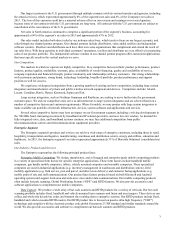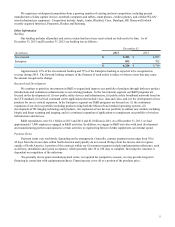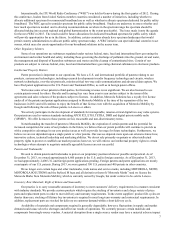Motorola 2013 Annual Report Download - page 15
Download and view the complete annual report
Please find page 15 of the 2013 Motorola annual report below. You can navigate through the pages in the report by either clicking on the pages listed below, or by using the keyword search tool below to find specific information within the annual report.13
materials, problems with our subcontractors or suppliers and other cost overruns, can result in the contract pricing becoming
less favorable or even unprofitable to us and have an adverse impact on our financial results. In addition, a significant increase
in inflation rates could have an adverse impact on the profitability of longer-term contracts.
Over the last several years we have outsourced portions of certain business operations like IT, HR information systems, repair,
distribution and engineering services and may outsource additional business operations which limits our control over these
business operations and exposes us to additional risk as a result of the actions of our outsource partners.
As we outsource more of our business operations we are not able to directly control these activities. Our outsource
partners may not prioritize our business over that of their other customers and they may not meet our desired level of service,
cost reductions or other metrics. In some cases their actions may result in our being found to be in violation of laws or
regulations like import or export regulations. As many of our outsource partners operate outside of the U.S., our outsourcing
activity exposes us to information security vulnerabilities and increases our global risks. In addition, we are exposed to the
financial viability of our outsource partners. Once a business activity is outsourced we may be contractually prohibited from or
may not practically be able to bring such activity back within the Company or move it to another outsource partner. The
actions of our outsource partners could result in reputational damage to us and could negatively impact our financial results.
We utilize the services of subcontractors to perform under many of our contracts and the inability of our subcontractors to
perform in a timely and compliant manner could negatively impact our performance obligations as the prime contractor.
We engage subcontractors on many of our contracts and as we expand our global solutions and services business our use
of subcontractors has and will continue to increase. Our subcontractors may further subcontract performance and may supply
third-party products and software. We may have disputes with our subcontractors, including disputes regarding the quality and
timeliness of work performed by the subcontractor or its subcontractors and the functionality, warranty and indemnities of
products, software and services supplied by our subcontractor. We are not always successful in passing down customer
requirements to our subcontractors, and thus in some cases may be required to absorb contractual risks from our customers
without corresponding back-to-back coverage from our subcontractor. Our subcontractors may not be able to acquire or
maintain the quality of the materials, components, subsystems and services they supply, or secure preferred warranty and
indemnity coverage from their suppliers which might result in greater product returns, service problems, warranty claims and
costs and regulatory compliance issues and could harm our business, financial condition and results of operations.
Many of our components and products, including software, are designed, developed and/or manufactured by third-parties and
if such third-parties lack sufficient quality control, change the design of components or if there are significant changes in the
financial or business condition of such third-parties, it may have a negative impact on our business.
We rely on third-parties to design, develop, and/or manufacture many of our components and finished products, as well
as provide us with software necessary for the operation of those products and we may increase our reliance in such third-parties
in the future. We could have difficulties fulfilling our orders and our sales and profits could decline if: (i) we are not able to
engage such third-parties with the capabilities or capacities required by our business, (ii) such third-parties lack sufficient
quality control and fail to deliver quality components, products, services or software on time and at reasonable prices or deliver
products, services or software that do not meet regulatory or industry standards or requirements, (iii) if there are significant
changes in the financial or business condition of such third-parties or (iv) if we have difficulties transitioning operations to such
third-parties.
In addition, certain key component suppliers are reducing the expected lifetime of key components, in particular
semiconductors, on some of our products which could result in the need for more frequent product redesigns on some products
or higher last time buys.
Our employees, customers, suppliers and outsource partners are located throughout the world and, as a result, we face risks
that other companies that are not global may not face.
Our customers and suppliers are located throughout the world. In 2013, more than 43 percent of our revenue was
generated outside the U.S. In addition, we have a number of manufacturing, research and development, administrative and
sales facilities outside the U.S. and more than 50% of our employees are employed outside the U.S. Most of our suppliers'
operations are outside the U.S. and most of our products are manufactured outside the U.S.
Because we have sizeable sales and operations, including outsourcing and procurement arrangements, outside of the
U.S., we have more complexity in our operations and are exposed to a unique set of global risks that could negatively impact
sales or profitability, including but not limited to: (i) import/export regulations, tariffs, trade barriers and trade disputes,
customs classifications and certifications, including but not limited to changes in classifications or errors or omissions related
to such classifications and certifications; (ii) changes in U.S. and non-U.S. rules related to trade, environmental, health and
safety, technical standards, consumer and intellectual property and consumer protection; (iii) longer payment cycles; (iv) tax
issues, such as tax law changes, variations in tax laws from country to country and as compared to the U.S., obligations under
tax incentive agreements, difficulties in repatriating cash generated or held abroad in a tax-efficient manner and difficulties in
























